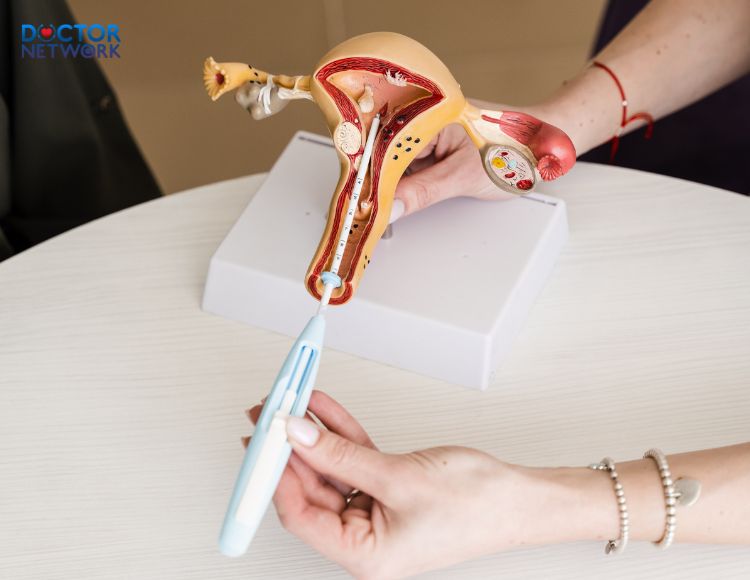Placing contraceptive rings is one of the modern and prevalent methods of contraception today. However, there can be instances where the placement of the ring is not appropriate. So, what are the signs of improperly placed contraceptive rings? Let’s explore them in the following article!
What is a Contraceptive Ring?
Contraceptive ring placement is an effective and popular method of contraception, especially favored among young women. It involves inserting a ring into the vagina, which releases hormones to prevent pregnancy by inhibiting ovulation and thickening the cervical mucus. To ensure safety and effectiveness, the placement of the ring needs to be carried out correctly, as signs of improper placement can lead to dangerous complications.

Placing contraceptive rings is a popular method of contraception nowadays
For women planning their reproductive health, choosing a contraceptive ring is a safe and flexible option. This can be either a cervical or hormonal intrauterine ring, capable of controlling ovulation, thickening cervical mucus, and even reducing menstrual pain. Depending on the type of ring and user requirements, the process of placing contraceptive rings can be performed in specialized healthcare facilities or women’s clinics.
Signs of Improperly Placed Contraceptive Rings
Below are common signs of improperly placed contraceptive rings:
1. Physiological Signs of Improper Placement
Some physiological signs of improperly placed contraceptive rings include persistent lower abdominal pain, menstrual irregularities, abnormal bleeding, mild fever, increased vaginal discharge, etc. These signs require prompt examination and intervention to avoid dangerous complications such as infections, uterine perforation, or infertility. Therefore, women should seek advice from specialized healthcare facilities for proper evaluation, screening, and correct placement of the ring. Proper placement of the ring according to guidelines ensures effective contraceptive prevention and safety for health.
2. Physical Signs of Improper Placement
Apart from physiological symptoms, physical signs of improperly placed contraceptive rings may indicate that the placement process was not carried out correctly.
External signs such as pelvic pain, discomfort, or a feeling of heaviness in the pelvic area may indicate that the ring has shifted from its original position or was not placed correctly in the uterus. Additionally, feeling the ring’s strings in the vagina or the ring protruding from the cervix are also signs of incorrect placement.
In some cases, patients may feel the ring under the skin in the lower abdominal area. This indicates that the ring has migrated out of the uterus, posing a risk of infection and calcification.
Placement Techniques and Related Practices
1. Position and Method of Ring Placement
Placing a contraceptive ring requires accuracy and high technical skill from healthcare professionals. The position and method of ring placement play a crucial role in ensuring efficacy and comfort for the user.
1.1 Ring Placement Position
- Cervical rings are usually placed in the uterus through the cervix.
- Hormonal rings are typically placed in the uterus or on the uterine walls.
- Correct placement ensures effectiveness and reduces the risk of ring migration.
1.2 Ring Placement Method
- The process can be carried out in healthcare facilities or women’s clinics.
- Ring placement methods may involve specialized instruments or suction tubes to facilitate easy movement and placement.
2. Ring Placement Techniques and Factors Affecting Process Quality
The process of ring placement is not only a simple technique but also requires attention to several determining factors for quality.
2.1 Accuracy in Positioning
Accuracy in placing the ring in the correct position is essential to ensure the highest efficacy of contraceptive rings.
2.2 Skills of the Ring Placer
Healthcare professionals performing ring placement need special skills and experience to minimize pain and risk.
2.3 Adjustment of the Ring if Necessary
After placing the ring, adjusting it to ensure comfort and safety is important.
3. Technical Standards to Follow
To ensure accurate and safe ring placement, specific technical standards must be followed.
3.1 Healthcare Organization Standards
Healthcare organizations have their guidelines and standards for contraceptive ring placement, which ring placers must be familiar with.
3.2 Training and Certification
Those performing ring placement need to undergo in-depth training and hold relevant certification to ensure necessary skills and knowledge.

The placement of contraceptive rings should be carried out by healthcare professionals with expertise in this field
3.3. Continuous Research and Updates
Physicians and healthcare staff involved in ring placement should continuously update their knowledge with the latest research and advancements in the field.
Points to Note During Ring Placement
1. Risks of Inappropriately Sized Rings
Choosing the appropriate size of the contraceptive ring is crucial to ensuring effectiveness and comfort for the user. The risk of improperly sized rings is not only a safety issue but also affects the efficacy of this contraceptive method.
Risk of Unintended Pregnancy
- An oversized ring may not fit tightly in the uterus, increasing the risk of unintended pregnancies.
- Conversely, an undersized ring may not provide adequate adhesion and may move, reducing contraceptive effectiveness.
Risk of Injury
Improperly sized rings may cause damage to the uterine lining or cause pain and discomfort for the user.
2. Issues Related to Incorrect Ring Material
The material of the contraceptive ring plays a significant role in ensuring safety and comfort. Issues related to material can affect the effectiveness and health of the user.
Allergic Reactions to Material
Some women may have allergic reactions to specific materials used in contraceptive rings, leading to problems such as irritation, redness, or itching.

Some women may have allergic reactions to specific materials used in contraceptive rings
Material Durability Issues
Low-quality materials may lead to ring deterioration, reducing contraceptive effectiveness and requiring more frequent ring replacements.
3. Factors Affecting Ring Placement Efficacy
Hormone Interactions
Research on the interaction between the ring and hormones is essential to ensure no adverse effects on weight, mood, or menstrual cycles.
Quality Control of Production
Ensuring that the contraceptive ring production process complies with quality standards to maintain product efficacy.
Environmental Impact
Researching how environmental factors, such as temperature and humidity, can affect the efficacy of contraceptive rings.
Continuous monitoring and evaluation of contraceptive ring efficacy are essential to ensure safety and meet user needs. Addressing size and material-related issues is crucial to optimizing the effectiveness and comfort of this contraceptive method.
Some scientific researches related studies to “signs of improperly placed contraceptive rings”
Hear are some scientific researches about “signs of improperly placed contraceptive rings“:
1. A study by the Centers for Disease Control and Prevention (CDC) in 2015 showed that the rate of complications due to improperly placed rings ranged from 0.4% to 1.6%. Common complications included infection, ring displacement, and uterine perforation.
2. According to a study published in the European Journal of Obstetrics & Gynecology and Reproductive Biology in 2021, symptoms such as lower abdominal pain, menstrual irregularities after ring placement may be due to the ring moving or not being correctly positioned in the uterine cavity.
3. A report in the American Journal of Obstetrics & Gynecology in 2017 indicated that the risk of complications increases if the ring is placed in the wrong position, not correctly positioned, lacks sterility, or if rough manipulation occurs.
4. According to a study by Harvard Medical School, physical signs such as pelvic pain, feeling the ring protruding from the cervix are evidence that the ring is not correctly positioned in the uterine cavity.
Thus, scientific studies have demonstrated a correlation between improperly placed rings and an increased risk of complications in women. Therefore, adherence to proper ring placement procedures and techniques is crucial.
The article has provided information on “signs of improperly placed contraceptive rings” and related knowledge. Hopefully, the article will be useful to you.
References:
Inadvertent intravesicular placement of a vaginal contraceptive ringnih·1
Kiểm Duyệt Nội Dung
More than 10 years of marketing communications experience in the medical and health field.
Successfully deployed marketing communication activities, content development and social networking channels for hospital partners, clinics, doctors and medical professionals across the country.
More than 6 years of experience in organizing and producing leading prestigious medical programs in Vietnam, in collaboration with Ho Chi Minh City Television (HTV). Typical programs include Nhật Ký Blouse Trắng, Bác Sĩ Nói Gì, Alo Bác Sĩ Nghe, Nhật Ký Hạnh Phúc, Vui Khỏe Cùng Con, Bác Sỹ Mẹ, v.v.
Comprehensive cooperation with hundreds of hospitals and clinics, thousands of doctors and medical experts to join hands in building a medical content and service platform on the Doctor Network application.

























